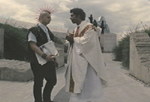Scholars at the American Academy of Religion Discuss "Jesus Christ, Vampire Hunter"di Massimo Introvigne
Controversial Canadian movie Jesus Christ, Vampire Hunter, directed by Lee Gordon Demarbre, was shown to a capacity crowd of scholars at the annual meeting of the American Academy of Religion (AAR) in Toronto on November 23, 2002, and discussed in two different sessions. For those who have not seen it, the movie is a bizarro crossover between blasphemous comedy and horror. It opens with vampires suspiciously operating in daily sunlight, inducing two priests to call in for help none less than Jesus Christ himself. The Lord agrees to intervene, performs a couple of miracles in order to prove that he is indeed the Son of God, gets an haircut and an ear piercing, and is attacked by a gang of atheists. He defeats them by showing a truly divine command of martial arts. Back to the apartement the local parish has prepared for him, he finds there Mary Magnum (i.e., obviously, Marry Magdalene), a curvaceous fighter who attacks him but is, however, on his side, and belongs to a secret organization of vampire hunters whose existence is known only to the Vatican (her business card, however, has an E-mail address at vatican.com, while – perhaps unbeknowst to the scriptwriter – the correct address should be vatican.va). Jesus and Mary prepare their stakes to battle the vampires, but the first encounter show that they are not that easy to get, even by hunters endowed with ultimate supernatural powers. In fact, a crazy doctor has discovered that replacing their undead skin with fresh skin taken from newly deceased lesbians make them immune to sunlight. They also have double agents among the Catholic clergy, ready to betray Jesus and his friends. Mary is turned into a vampire,and Jesus is left bleeding in a back alley. In a modern retelling of the Samaritan story, a policeman and a priest ignore him, and the only person who cares is a transexual prostitute. At this stage, with the movie becoming increasingly bizarre, Jesus decided he needs help and enlists Santo, a well-known figure in the old Mexican wrestling movies (where, of course, he did fight vampires). Santos and Jesus trace the vampires back to a night club, where Santo falls in love with a lesbian. Both Santos and Jesus are captured by the vampires but in the final battle they defeat them. Jesus, now in his full power and glory, turns Mary back into a human being only to discover that she, too, has turned lesbian during her short existence as a vampire, whilst Santo’s love interest, also duly resurrected, is at least bisexual. The movie concludes with a Canadian version of the Sermon on the Mount in a park, so politically correct that Jesus tells the audience not to believe his words merely because of himself and to rather trust their own judgement. This looks very much like a farce à la Monty Python, only much worse and calculate to enrage Christians (actually, during the show at the AAR some veiled female Moslem scholars did leave the room finding the movie blasphemous – Jesus Christ being obviously a prophet for Islam). It is a testament to the deeply secularized nature of English-speaking Canada that there has been, apparently, very few controversy. As a farce, the movie was a hit with the younger scholars at AAR but left the older more cold and perplexed. In the sessions, some scholars suggested however that the movie is not perceived as a mere farce. According to Laurel Zwissler, from the University of Toronto, a sizeable portion of the viewers she surveyed did identify with Jesus Christ as superhero (although of course the comedy element could not be lost to anybody). Making Jesus Christ into a superhero (with limitations as well as superpowers) is a way to make him relevant again, Zwissler said, in a deeply secularized society such as modern-day Ontario. AAR scholars tried to interpret the movie’s theology. If there is one, it is obviously liberal, with Jesus Christ refusing to condemn homosexual as well as etherosexual prostitutes, and a transvestite cast in the role of the good Samaritan. The Sermon on the Mount would please the Jesus Seminar more than Jean Paul II (who, in fact, calls Jesus on his cell phone during the sermon in the movie; Jesus would only talk to him later, however, and we may only suspect what the conversation will be about). Mary Magdalene is duly sexy and feminist, with reminiscences (Zwissler said) of Buffy the Vampire Slayer, although she is much more similar to Joe Benitez’s The Magdalena, who in her own comic series battles vampires and is part of an unbroken chain of vampire hunters going back to the Magdalene of the Gospels. Zwissler did mention some comics, but they are those where Jesus Christ is portrayed as a vampire (taking to extremes the eucharistic metaphor in Dracula), whose message is reversed here by making Jesus Christ into a vampire hunter. Discussions at the AAR prove that vampire themes are relevant to the religious scholars (another paper discussed several characters in the Buffy TV series and their relationships with evil), and that the movie has potential for generating theological discourse, but whether this is caught by the average viewer remains to be seen. Many will only see the farce, and as a farce the movie is blasphemous (although theologians in the AAR panels were quick to remember that blasphemy may be the mask for a secret prayer). Others would regard Demarbre’s Jesus as just a bit too much politically correct. |







